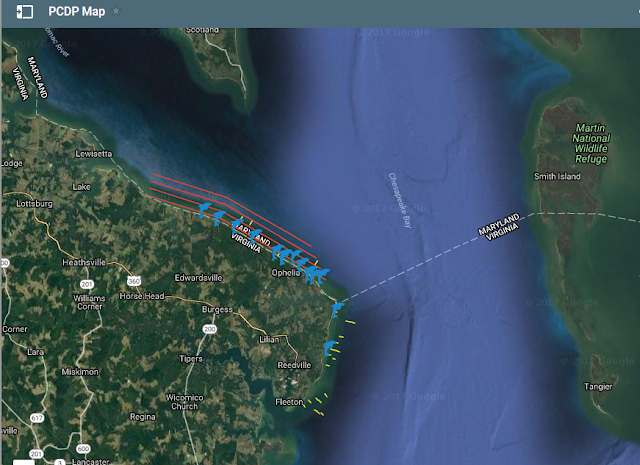Bottlenose dolphins have visited the Potomac River going back to at least the 1800s, according to Atlas Obscura's The Mysterious Dolphins of the Potomac. They've entertained themselves and others along the way.
The Potomac-Chesapeake Dolphin Project (PCDP) has identified approximately 500 dolphins in the 37 square kilometers near the mouth of the Potomac River at the Chesapeake Bay. PCDP staff and volunteers are photographing them and the organization is naming the dolphins after significant historical figures in U.S. history starting with the Founding Fathers. The named dolphins slideshow and the map below provide additional information about the dolphins and where they were sighted.
But despite their long history of visiting the area, there's much more to know about the dolphins. PCDP and the Chesapeake Biological Laboratory in the University of Maryland Center for Environmental Science are researching the Potomac-Chesapeake bottlenose dolphins. PCDP is interested in learning about the abundance and distribution of these dolphins, the population structure, and the social behavior and disease risk. The University of Maryland team is "studying how often dolphins actually come into the Chesapeake Bay, how long they spend here, what areas of the Bay they are using and why."
Both Potomac-Chesapeake Dolphin Project and the University of Maryland are taking advantage of the public's interest in dolphins. The latter founded Chesapeake DolphinWatch. "Within the first month of the launch, more than 1,300 users registered to use the Chesapeake DolphinWatch app and reported roughly 700 sightings." Colonial Beach Dolphins, Dr. Caryn Self-Sullivan, is one such citizen scientist (actually, she is a scientist scientist). She created the Facebook page to collect information and pictures about dolphin sightings around Colonial Beach and now reports sightings to Chesapeake DolphinWatch.
The Potomac-Chesapeake Dolphin Project (PCDP) has identified approximately 500 dolphins in the 37 square kilometers near the mouth of the Potomac River at the Chesapeake Bay. PCDP staff and volunteers are photographing them and the organization is naming the dolphins after significant historical figures in U.S. history starting with the Founding Fathers. The named dolphins slideshow and the map below provide additional information about the dolphins and where they were sighted.
But despite their long history of visiting the area, there's much more to know about the dolphins. PCDP and the Chesapeake Biological Laboratory in the University of Maryland Center for Environmental Science are researching the Potomac-Chesapeake bottlenose dolphins. PCDP is interested in learning about the abundance and distribution of these dolphins, the population structure, and the social behavior and disease risk. The University of Maryland team is "studying how often dolphins actually come into the Chesapeake Bay, how long they spend here, what areas of the Bay they are using and why."
Both Potomac-Chesapeake Dolphin Project and the University of Maryland are taking advantage of the public's interest in dolphins. The latter founded Chesapeake DolphinWatch. "Within the first month of the launch, more than 1,300 users registered to use the Chesapeake DolphinWatch app and reported roughly 700 sightings." Colonial Beach Dolphins, Dr. Caryn Self-Sullivan, is one such citizen scientist (actually, she is a scientist scientist). She created the Facebook page to collect information and pictures about dolphin sightings around Colonial Beach and now reports sightings to Chesapeake DolphinWatch.


